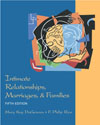Marriage relationships are never static; their quality varies by phases or
stages in the family life cycle. Weishaus and Field describe six different models
of long-term marriages. A curvilinear pattern is most common: marital satisfaction
tends to be high at the time of marriage, lowest during child-rearing years,
and higher again after the youngest child is beyond the teenage years. Although
gay and lesbian families are usually headed by same-sex couples and often face
stigmatization, unacceptable, and discrimination, research consistently shows
that they are just as successful in carrying out normal family roles and tasks
and at child rearing as are other family types. Couples face different marital
adjustment tasks in each phase of marriage. During the early stages of a relationship,
disillusionment can occur for couples who have not realized what marriage really
involves. Money tends to be the largest problem throughout marriage. Parenthood
experiences can be positive, neutral, or negative, depending on the family.
Sources of strain include single parenthood, the greater responsibility typically
placed on mothers rather than fathers, and additional children. Midlife requires
adjustment to physical changes and to a reexamination of career and marriage
concerns. Postparental years can bring adjustment to an "empty nest."
Older adults need to adjust to changes in physical health, changes in income,
and forced retirement--which can bring problems of maintaining identity and
social status and companionship. Loneliness can become a problem for the divorced
and widowed, especially for women. Issues relating to who will care for people
as they get older are becoming more critical as longevity is increasing. |



 2002 McGraw-Hill Higher Education
2002 McGraw-Hill Higher Education